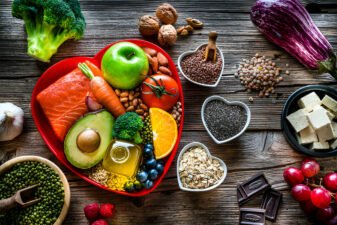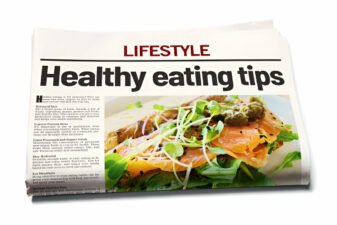Official dietary guidelines for balanced healthy eating (illustrated by the Food Guide Pyramid) are issued by the US Department of Agriculture.
Healthy Eating Guidelines for Americans
The Dietary Guidelines for Americans attempt to answer three questions: What should we eat, how should we prepare it to keep it safe and nutritious, and what sort of exercise is best for good health. In the latest Dietary Guidelines, published January 2005, there is a new emphasis on weight management, along with more specific diet advice on fats, carbohydrate and dairy foods.
The Dietary Guidelines of 2000 attracted criticism from several dietitians, nutritionists and expert groups (eg. Harvard School of Public Health, who built their own Healthy Eating Pyramid). These critics have welcomed several of the new diet recommendations contained in the 2005 Dietary Guidelines – on issues like weight control, consumption of trans-fats and whole grains – but concerns remain. Even so, these new guidelines for healthy balanced eating are a considerable improvement on the old ones and should generally be welcomed.
Dietary Guidelines for Americans (2005) – Main Recommendations
Basic Advice About Balanced Diet
- Consume a variety of nutrient-dense foods and drinks among the basic food groups. Choose foods that restrict your intake of saturated and trans fats, cholesterol, added sugars, salt, and alcohol.
- Follow a balanced eating pattern, such as the U.S. Department of Agriculture (USDA) Food Guide or the Dietary Approaches to Stop Hypertension (DASH) Eating Plan.
Recommendations For a Balanced Diet
- Consume an adequate amount of fruit and vegetables but stay within the correct calorie level for a healthy weight.
- On a 2000-calorie diet, eat 2 cups of fruit and 2 and a half cups of vegetables per day. Eat more or less according to your calorie needs.
- Eat a variety of fruit and vegetables each day. Choose from all five vegetable sub-groups (dark green, orange, legumes, starchy vegetables, and other vegetables) several times a week.
- Consume 3 or more ounce-equivalents of whole-grain foods each day, with the rest of the recommended grains coming from enriched or whole-grain products. At least half your grains should come from whole grains. Eating at least 3 ounce-equivalents of whole grains per day can reduce the risk of heart disease, may help with weight maintenance, and will lower your health risk for other chronic diseases.
- Consume 3 cups per day of fat-free or low-fat milk or equivalent milk products.Adults and children can consume milk and milk products without worrying that these foods lead to weight gain. There are many fat-free and low-fat choices without added sugars that are available and consistent with an overall healthy dietary plan. If a person has difficulty drinking milk, …choose alternatives within the milk food group, such as yogurt or lactose-free milk, or consume the enzyme lactase prior to the consumption of milk products. For people who must avoid all milk products (e.g. individuals with lactose intolerance, vegans), non-dairy calcium-containing alternatives may be chosen to help meet calcium needs.
Dietary Fat in a Balanced Diet
- Eat less than ten percent of calories from saturated fats and less than 300 mg/day of cholesterol, and eat as few trans-fats (hydrogenated fat) as possible.
- Maintain your total intake of fats/oils at between 20-35 percent of calories, with most fat coming from polyunsaturated and monounsaturated fat, such as oily fish, nuts, and vegetable oils.
- Regarding meat, poultry, dry beans, and milk or milk products, choose lean, low-fat, or fat-free options.
Carbohydrate in a Balanced Diet
- Eat fiber-rich fruits, vegetables, and whole grains as often as possible.
- Consume foods and drinks with little added sugars or caloric sweeteners. Follow the recommendations in the USDA Food Guide and the DASH Eating Plan.
Dietary Protein in a Balanced Diet
The Dietary Guidelines did not directly address the issue of protein. They state:
“While protein is an important macronutrient in the diet, most Americans are already currently consuming enough and do not need to increase their intake. As such, protein consumption, while important for nutrient adequacy, is not a focus of this document.”
However, they do recommend you to choose foods that contain lean protein. They state:
Eat lean meats and poultry. Bake, broil, or grill food.
Eat a variety of protein rich foods, with more fish, beans, peas, nuts and seeds.
Dietary Sodium and Potassium
- Eat less than 2,300 mg (approximately 1 teaspoon of salt) of sodium per day.
- Choose low-sodium foods, and do not add salt when cooking. Also, eat potassium-rich foods, such as fruits and vegetables.










